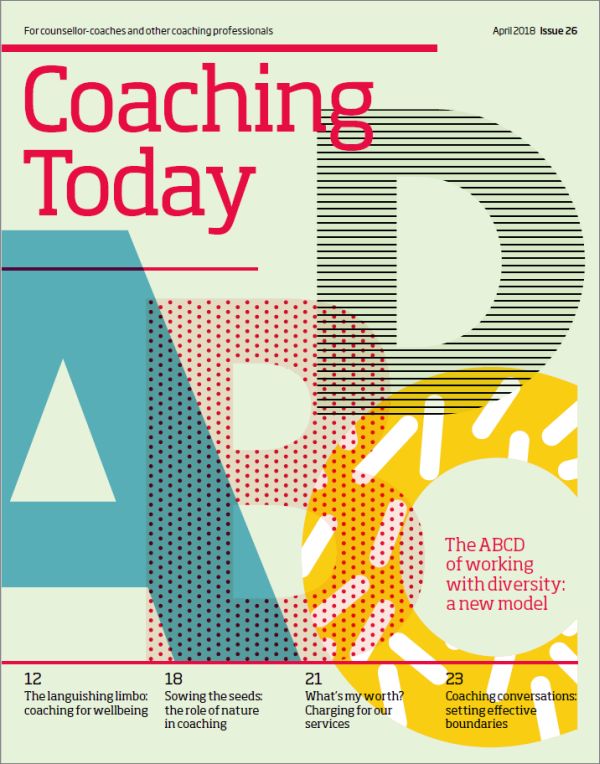In this issue
Features
The ABCD of working with diversity: a new model (free article)
Katharine Collins
The languishing limbo: coaching for wellbeing
Jolanta Burke
Coaching conversations: setting effective boundaries
Sally Brown
Regulars
Opinion
Nature has a role to play in coaching
Margaret Walsh
Ask the Executive
‘How do I set my prices as a coach?’
Meet the member
Sue Sutcliffe

A pdf of this issue is available in the Coaching Today archive.
Editorial
If you were at our Working with Coaching day in London back in January (or if, like me, you weren’t able to attend, our Chair Eve Menezes Cunningham includes an excellent conference report in her regular message), you will have seen our lead writer in this issue, Katharine Collins, speak about her experiences of working with difference in the coaching relationship.
When we encounter clients who we perceive as somehow different from us, this can sometimes (though not always) engender feelings of inadequacy or guilt, or simply a sense of being unable to provide what the client needs, or feeling ‘out of our depth’. These perceived differences can range from the more obvious markers such as race, religion, gender, sexuality, ethnicity, age and class, but can also encompass more subtle differences, such as lifestyle choices. In my private practice, I tend to attract people – mainly women – who work in the arts and creative or helping professions, and who lead a ‘multipotentialite’ or ‘scanner’ kind of lifestyle, meaning that they don’t necessarily have one dominant career path but tend to have a variety of projects on the go at any one time. In other words, women much like me. They may work in a different medium to me – the landscape gardener who makes music, the yoga instructor who writes poetry, the actor who is undertaking a part-time counselling degree – but already we have a shared understanding of the field, and I know they are drawn to me for that reason. It is only in the past few years, since expanding my practice into different areas, that I have been pushed out of my comfort zone and challenged to work with people who, at a superficial level at least, appear to be very different from me. In such cases, I have found myself looking for the common ground, the area in which we meet and where – to paraphrase the former Labour MP Jo Cox, who Katharine quotes in her article – ‘we have more in common than the things that divide us’.
Using her work with lesbian, gay, bisexual, transgender and queer (LGBTQ) communities as a starting point, Katharine describes how she was challenged when she found herself working with a client who she experienced at first as very different from her. In acknowledging that, for her, working with diversity was not confined to the LGBTQ community, she used this experience to devise and develop a simple model for working with diverse populations, and I am delighted that she has chosen to share this with us – and her own story of how she was inspired – here in this issue.
As coaches, we can often find ourselves working with clients who may have previous experience of being in therapy – or indeed who may still be seeing a therapist in conjunction with their coaching work with us. Even those of us who work integratively may be operating more at the coaching end of the scale with a particular client, particularly if that client already has a long-standing relationship with an existing therapist. You may have also encountered clients who are stuck in what Dr Jolanta Burke describes as ‘the languishing limbo’: clients who are not – or are no longer – deemed mentally unwell, but who are far from flourishing either. In her special feature in this issue, Jolanta examines a range of wellbeing models and demonstrates how we coaches, using our own therapeutic knowledge, are uniquely placed to help clients out of the languishing limbo and into a place where they are able to thrive, rather than merely survive.
Establishing, maintaining and navigating boundaries is a crucial part of the work we do with our clients, perhaps even more so for those of us working at the boundary of coaching and counselling/psychotherapy. So when BACP Coaching’s Executive Specialist for Communication, Sally Brown, suggested that she compile a third Coaching Conversations feature on this subject, I was so excited I offered to add my voice to the mix. The result is an article featuring the views of a range of coaches (including yours truly), exploring how we navigate and negotiate boundaries in our work with clients, if these differ from our therapeutic boundaries, and if so – how?
Finally, by the time you read this, spring will have well and truly sprung (I hope), and in that spirit, Margaret Walsh makes a compelling case for bringing more of the natural world into our coaching relationships. With all this talk of fields, diversity, thriving, flourishing and boundaries, it’s already there in the language that we use. What do you think? Drop me a line and let me know.
May we tend to our gardens and may the seeds we sow flower.
Until next time…
Diane Parker
Editor
editorial@bacpcoaching.co.uk
